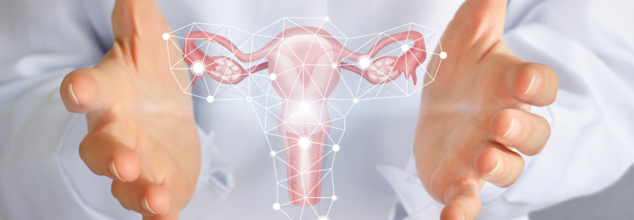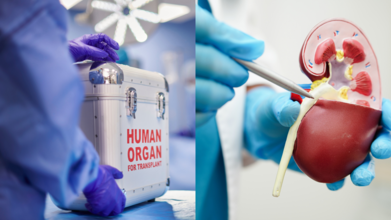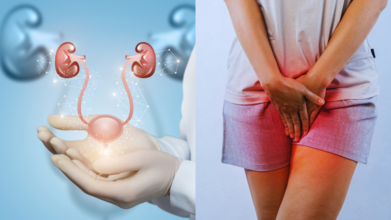- Health Conditions A-Z
- Health & Wellness
- Nutrition
- Fitness
- Health News
- Ayurveda
- Videos
- Medicine A-Z
- Parenting
- Web Stories
Does Your Cervix Change Its Shape Throughout Your Life?

Credits: Canva
Did you know your cervix moves and changes during your menstrual cycle? If you're trying to get pregnant or just want to understand your body better, learning about your cervix can be really helpful. Here’s how you can check it yourself, what those changes mean, and how to keep it healthy.
What and Where Is the Cervix?
The cervix is the lower part of your uterus, connecting it to your vagina. It’s about an inch wide and looks a bit like a small donut with a tiny hole in the center. The word "cervix" comes from Latin, meaning the “neck” of the womb. You’ll find it deep inside your vagina, and its position changes depending on where you are in your cycle.
Why Is the Cervix Important?
The cervix does a lot for your body:
- Lets blood flow out during your period
- Helps sperm enter your uterus during ovulation
- Keeps out bacteria with a protective mucus barrier
- Seals shut during pregnancy to protect the baby
- Opens up during birth to allow the baby to pass
How the Cervix Changes During Your Cycle
Your cervix moves and feels different at various times in your cycle:
- During ovulation (when you're most fertile), it moves higher up, feels soft (like lips), and opens slightly to let sperm in.
- After ovulation, it lowers again, feels firmer (like the tip of your nose), and the opening closes.
- Right before your period, it drops even lower and stays firm.
- During your period, it stays low and slightly open so blood can flow out.
How to Check Your Cervix?
You can check your cervix at home using clean hands and a gentle touch. Here's how:
- Wash your hands well – this helps avoid infections.
- Get into a comfortable position – like sitting on the toilet, squatting, or standing with one leg raised.
- Gently insert a finger into your vagina and reach upward.
- Feel for the cervix – it’s round and firmer than the rest of your vaginal walls.
Take note of what you feel:
Is it soft or firm?
Is it high or low?
Is it open or closed?
Your cervix may feel softer and higher during ovulation and lower and firmer before your period. If you've given birth before, your cervix might always feel slightly open.
Tip: Don’t check your cervix right after sexual activity—it can move due to arousal. Try checking it at the same time every day to track changes more easily.
What Cervix Changes Can Tell You
Noticing how your cervix feels and where it is can give clues about your fertile window, especially if you're trying to get pregnant. During ovulation, you may also see more clear, slippery cervical mucus, which helps sperm travel easily.
Learning how your cervix changes is a simple, natural way to understand your cycle better. Whether you're planning for pregnancy or just curious about your body, this self-check is a helpful tool. Be patient—it may take a few tries to get familiar with how your cervix feels, but it’s a great step toward body awareness and better reproductive health.
Lactic Acid in Goat Milk: The Gentle Skin Smoother That Works — But Is It All Hype?

Historically, people have been slathering its goat milk goodness on their skin thanks to its rich fats and skin-loving nutrients. Lactic acid is a naturally occurring alpha-hydroxy acid (AHA) found in goat milk. It works by breaking the “glue” between dead skin cells, letting them slide off more easily to reveal fresher, smoother skin underneath.
Dead skin cells can more easily slide off to reveal the smoother, lighter skin underneath when lactic acid breaks down the bonds holding them together. In higher concentrations (like the 5–12% found in targeted skincare products), lactic acid boosts radiance, hydrates, and softens fine lines. In goat milk, however, the concentration is lower, which means it’s milder but slower to deliver visible results.
The Gentle but Patient Approach
“As goat milk contains less lactic acid than pure lactic acid, it is weaker but still works,” says Dr. Sooriya. “This reduces the possibility of irritation brought on by higher AHAs, making it good for people with dry skin.”
This gentleness is exactly why it’s a safe choice for sensitive skin.
Dr. Katheeja Nasika points out that the fatty acids, antioxidants, and bioactive proteins in goat milk help maintain the skin barrier and suppress inflammation, a bonus you don’t always get from stronger chemical exfoliants.
Manage Your Expectations
Here’s where the bubble bursts for anyone hoping for overnight miracles. Goat milk won’t banish deep wrinkles, stubborn pigmentation, or cystic acne. It’s not meant to.
“You should not rely solely on goat milk to remove large pimples, wrinkles, or dark spots,” advises Dr. Sooriya. “Add active ingredients like vitamin C or niacinamide, in moderation, to help in the process.”
Similarly, Dr. Nasika emphasises that while goat milk can enhance hydration and texture, the lactic acid content is low and variable, making results subtle and unpredictable. In other words, it’s more of a maintenance player than a star striker in your skincare squad.
Where Goat Milk Shines
If your skincare goals are about gentle exfoliation, daily nourishment, and barrier support, goat milk ticks the boxes. Used in soaps, cleansers, and lotions, it:
- Softly removes minor discolourations
- Hydrates the skin with its blend of vitamins A and D
- Supports cell turnover without triggering redness
- Adds a touch of radiance over time
- Goat milk is also especially handy for those who can’t tolerate stronger AHAs but still want some exfoliation in their routine.
Gentle, Yes. Overhyped? Not Exactly.
Calling goat milk “overhyped” depends on what hype you have been sold. If you have been promised a miracle in a bar of soap, that’s overselling it. But if you understand it as a slow, steady, and skin-friendly option, it’s a quiet achiever.
“It might not work miracles, but it’s a good way to clean your skin without harming it and gain extra nutrients at the same time,” says Dr. Sooriya.
Dr. Nasika agrees, noting that it’s particularly suited for sensitive skin as a maintenance therapy, just don’t expect it to replace higher-strength exfoliants when dealing with pigmentation or fine lines.
- Good for: Sensitive skin, dry skin, gentle daily exfoliation, hydration
- Not so good for: Deep pigmentation, pronounced wrinkles, active acne
- Best used as: A daily cleanser or lotion, paired with other active ingredients (used carefully) for bigger skincare goals
World Organ Transplant Day: From 3D Printing To Lab-Grown Organs, Transplant Breakthroughs Are Here

On World Organ Transplant Day, we usually hear about the urgent need for more donors, the lifesaving power of a transplant, and how one person’s decision can save up to eight lives. That is all still true and still critical but here is the twist: while the waiting lists grow, so do the technologies that might one day make them shorter or even unnecessary.
The future of organ transplantation is not just beating in donor hearts anymore; it is also whirring in lab incubators, spinning in magnetic rotors, and taking shape layer by layer on 3D bioprinters.
Despite decades of successful surgeries, the biggest roadblock in transplantation remains supply. Dr Bipin Chevale, CEO of Gleneagles Hospital Mumbai, explains, “There is still a persistent disparity between organ supply and demand. In India, thousands remain on waiting lists, and many lose their lives before a suitable organ becomes available.”
The reasons are a blend of low awareness, cultural taboos, and plain logistical hurdles. In 2023–24, nearly 50,000 Indians were waiting for organ replacement, according to the National Organ and Tissue Transplant Organisation (NOTTO). Globally, the US alone has more than 100,000 patients on transplant lists, with 13 lives lost every day while waiting.
Medical science, however, has been busy building backup plans. From 3D printing body parts to developing fully artificial organs, scientists are inching closer to a future where “no donor” does not mean “no hope”.
The Rise of 3D Bioprinting
Specialised 3D bioprinters can lay down living cells in precise patterns to create tissue that looks and behaves like the real thing.
Dr Varun Mittal, Head of Kidney Transplant at Artemis Hospitals, says researchers have “made great strides in printing living tissues and complicated networks of blood vessels”, something previously thought impossible. Techniques like Co-SWIFT create branching vessels inside heart tissue, while 3D ice printing uses water and gelatine to make smooth vessel templates.
While we are not yet popping out fully functional hearts or kidneys from printers for surgical use, these technologies are already valuable for training surgeons, testing drugs, and inching toward patient-specific implants. The idea is to design an organ to match a patient’s exact size, shape, and immune profile, dramatically lowering the risk of rejection.
Artificial Organs: Machines That Act Human
If printing an organ from scratch is the long game, artificial organs are the fast-forward button. These mechanical or bioengineered devices can take over the job of a failing organ, sometimes temporarily, sometimes for months or years.
One striking example is the BiVACOR artificial heart. It does not beat; it spins. A magnetic rotor pumps blood continuously, acting as a bridge until a donor heart is found. Dr Mittal points out that some patients have survived for months with the device, staying mobile and alert while awaiting surgery.
Similarly, researchers are developing implantable bioartificial kidneys that could filter blood and house living kidney cells without the need for dialysis or lifelong immunosuppressants. Wearable dialysis units are also in the works, aimed at freeing patients from hours tethered to clinic machines.
The Lung and Liver Challenge
Some of the boldest experiments are happening with lungs and livers, two of the trickiest organs to replace due to their complexity.
Dr Yasir Rizvi, Director of Nephrology and Kidney Transplant at Dharamshila Narayana Superspeciality Hospital, points to a landmark in lung research: a 3D-printed human-scale scaffold containing about 4,000 km of capillaries across 44 trillion voxels. In animal studies, it has already exchanged gases like a natural lung.
For the liver, bioprinting and bioengineering efforts aim to create functional tissue that can sustain patients until a full transplant is possible or even act as a permanent fix in the future.
The Benefits Are Already Here
We may still be a few years from printing a fully functional, transplant-ready heart, but artificial organ technology is already improving lives. Pacemakers, cochlear implants, and ventricular assist devices, these are all proof that machinery and biology can coexist in the human body.
Artificial organs have the potential to:
- Reduce rejection by using a patient’s own cells
- Cut waiting times dramatically
- Lower long-term medical costs by reducing hospital stays
- Give access to treatment in regions where donor organs are scarce
As Dr Chevale says, these breakthroughs are only half the story. “Their success will also depend on increasing awareness about organ donation, busting myths, and encouraging more people to pledge their organs.”
The Ethical Road Ahead
Of course, the march toward lab-grown and artificial organs comes with big ethical questions. Who gets them first? Will they be affordable or only for the wealthy? How do we ensure safety in devices meant to live inside fragile bodies?
Dr Rizvi believes that with “careful regulation, transparent trials and patient-centred design, these innovations can turn prototypes into standard care”. In India, collaborations between AIIMS, IITs, and bio-technical start-ups are already laying the groundwork, with the hope of producing affordable devices for both domestic and global use within a decade.
A Future Worth Donating To
Even if the day comes when a printer can make you a brand-new kidney, organ donation will still matter. Research organs, temporary implants, and hybrid solutions will always benefit from donated tissue to validate safety and function.
The future of transplantation is no longer just a race against the clock for a donor organ, it is also a race to develop, print, and perfect replacements that can save lives anywhere, anytime.
Experts Weigh In On Why White-Collar Workers And Women Are More At Bladder Health Risk

In the modern workplace, we have normalised the idea that meetings, presentations, and overflowing inboxes are perfectly good reasons to ignore the most basic biological urge, that is, the need to pee. This is not just mildly uncomfortable; it is slowly harming bladder health. Over-retention of urination has detrimental effects on the health of the bladder. The bladder is a muscle that should only distend or shorten so far. When we repeatedly hold it in, the bladder stretches beyond its usual limit, weakening over time and losing its sensitivity to fullness. This results in urinary retention, incomplete emptying, or even loss of bladder control in severe cases.
The Not-So-Harmless Habit
It is tempting to think that pushing back bathroom breaks is just an occasional inconvenience, but in reality, this behaviour is linked to much more than discomfort. Dr Nasreen Gite, Consultant Urologist at K J Somaiya Hospital and Research Centre, explains that prolonged retention “gives bacteria in the urinary tract time to multiply”, raising the risk of urinary tract infections (UTIs). Women are especially vulnerable due to their shorter urethras, making it easier for bacteria to reach the bladder. Over time, repeated overdistension can also cause urge incontinence or overactive bladder, that sudden, overwhelming need to go, often followed by leakage.
While continuously holding off on going to the bathroom overstretches bladder muscles and makes the bladder more sensitive and vulnerable to overactive bladder symptoms, it may also strain the pelvic floor muscles, affecting bladder control.
The Desk Job Dilemma
If you are thinking, “Well, I work in an office; it is not like I am operating heavy machinery in the middle of a field,” you might be more at risk than you think. Reportedly, this is increasingly a white-collar problem. Desk workers are often glued to their seats for long stretches, and corporate cultures can be surprisingly unsympathetic to frequent breaks.
Women face an extra layer of complexity. Beyond anatomy, sociocultural factors come into play, from the lack of clean workplace toilets to the subtle pressure of “powering through” without appearing weak. Dr Gite points out, “Women are anatomically more prone to bladder infections, and socialisation often leads them to ‘hold it in’ automatically.”
Dr Nagaveni R, Consultant Obstetrician and Gynaecologist at Motherhood Hospitals, Bengaluru, echoes this concern and adds that hormonal changes, particularly after childbirth or menopause, can heighten susceptibility to bladder issues.
Signs Your Bladder Needs Immediate Attention
Your bladder is a fairly patient organ, but it does have its limits. Dr Gite lists some tell-tale signs of trouble: frequent urination, painful or burning urination, nocturia (waking at night to urinate), and lower abdominal pain. In more severe cases, you might notice a weak urine stream, the sensation of incomplete emptying, or even leakage. Chronic UTIs or persistent pelvic pressure are also red flags.
For women, Dr Nagaveni adds, “Warning signs include urgency, pain, failure to completely empty the bladder, frequent UTIs, prolonged lower abdominal pressure, or leakage while coughing or sneezing.” Ignoring these signals in the name of work efficiency is, quite literally, asking for trouble.
The Corporate Culture Connection
What makes this problem so stubborn is that it is as much cultural as it is medical. The “bathroom break guilt” that pervades many workplaces frames such breaks as unproductive time, rather than essential self-care. In open-plan offices, there is often the subtle performance of staying seated for hours as proof of diligence. For remote workers, back-to-back virtual meetings can be equally unforgiving.
This is where change needs to be systemic. Employers must recognise that bladder health is not a “personal issue” to be managed privately but a workplace wellness concern. Encouraging regular breaks and ensuring clean, accessible facilities can reduce health risks and even boost productivity.
Practical Tips
For workers stuck in a culture of bladder neglect, a few small changes can make a big difference:
1. Listen to your body and do not wait until you are desperate.
2. Schedule mini-breaks every 2–3 hours, even during busy days.
3. Stay hydrated but space out your fluid intake to avoid overwhelming the bladder at once.
4. Advocate for clean facilities because workplace hygiene plays a huge role, especially for women.
5. Address symptoms early. Recurrent UTIs or leakage deserve medical attention, not self-diagnosis.
Understand that your bladder is a muscle with limits, one that needs serious attention if you want it to function well for decades to come. In the words of Dr Gite, “If symptoms do not subside, visit a doctor for immediate action.”
© 2024 Bennett, Coleman & Company Limited

